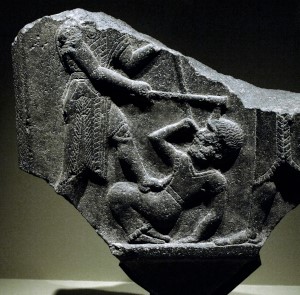River subbasins more depleted than
official figures show
09 April 2024
Published online 1 November 2023
A study charts an unknown history of violence in the Middle East, examining human skulls dating back 12,000 years
The English
philosopher Thomas Hobbes once argued that violence is innate to humankind,
describing existence as a “war of all against all”. Such a grim statement is
arguable. It is also unsupportable. If homo sapiens have walked the planet for well
more than 200,000 years, what do researchers know of violence in pre-history?
PHAS/Universal Images Group via Getty Images
Enlarge image
In a new study, conducted by an international team from the universities of Tübingen, Barcelona, and Warsaw, researchers used 3,539 sets of skeletal remains from the Middle East to reconstruct the early patterns human violence.
The study found that while widespread violence has been consistent in human history, it has been inconsistent in its intensity. Such findings yield clues about what drives fierce busts of human violence and calls into question some persistent assumptions.
Giacomo Benati, study co-author, says “[The study] fills a critical gap in our understanding of early human populations, particularly in regions where similar long-term data and wide scale analyses have been lacking. It also calls into question the prevailing narrative that portrays Middle Eastern communities as zones of perpetual conflict.”
A New View on Violence
In the study, researchers examined human remains from Iran, Iraq, Jordan, Syria, Lebanon, Palestine and Turkey for bone injuries that can be only inflected through acts of violence. The team used that data to reconstruct the pattens of human violence between 12,000 BC to 400 BC. That period saw the dawn of agriculture, the abandonment of the nomadic life and the establishment of the earliest cities and states.
According to the study, levels of violence in the region coincided with the appearance of the earliest cities. As primitive states emerged, communities saw increased population density, a widening gap of social inequity, and competition for resources. The authors suggest that such pressures drove frequent organized conflicts.
Patterns of violence appear to peak in the Copper Age (Circa 4500 BC to 3300 BC), as indicated by bashed skulls and weapon-inflected wounds, and then decline in the early/mid Bronze Age (Crica 3300 BC to 1500 BC). The authors suggest the appearance of centralized governments and the development of legal systems played a pivotal role in reducing conflict. The findings also point to the expansion of trade networks as a balm for violence in the region. The authors suggest that economic cooperation between cities and states could have fostered cultural interactions and imparted an economic incentive to maintain peace.
In the late Bronze Age into the Iron Age (Crica 1500 BC to 400 BC), the authors indicate that violence rose once more, and then appeared to oscillate between periods of relative peace and unrest. Why this might be is unclear, though Benati points to possibilities such as climate crises, internal instability, and foreign invasions.
“Understanding such fluctuations offers us a better estimate of the role violence played within the historical development of Middle Eastern communities,” he says.
Broad implications
While the study focused on remains gathered in the Middle East, the research approach could apply elsewhere. “Modern times have only access to traditional data sources, such as murder records or records of battle deaths, which leaves large gaps unexplored in the history of mankind,” Benati says. “Such data gaps impede us from accurately tracking the trends of violence, particularly in illiterate and non-western communities, which stresses the need for innovative methods such as those used in this study to provide insights into ancient violence patterns”.
For instance, while the study did not examine remains from Egypt, Benati told Nature Middle East that based on the team’s findings, he would expect lower levels of violence levels during periods of more centralized pharaonic rule.
Brian Coding, an anthropologist from the University of Utah who did not participate in the research, says the study could also hold lessons for modern societies.
Says Coding, the paper furthers knowledge of the historical drivers of conflict, which could help others understand the future incentives behind violence. Such pressures as climate change and resource scarcity are just as applicable today as they were ages ago. By looking into the past, humankind might be better prepared for the future.
doi:10.1038/nmiddleeast.2023.223
Stay connected: